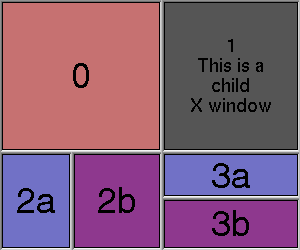Name
class Fl_Tile -- tiled window resizing widget
Include Files
#include <FL/Fl_Tile.H>
Description
The Fl_Tile class lets you resize the children by dragging
the border between them:
Fl_Tile allows objects to be resized to zero dimensions.
To prevent this you can use the resizable() to limit where
corners can be dragged to.
Even though objects can be resized to zero sizes, they must
initially have non-zero sizes so the Fl_Tile can figure out
their layout. If desired, call position() after creating the
children but before displaying the window to set the borders where you
want.
The "borders" are part of the children, an
Fl_Tile does not
draw any graphics of it's own. In the above example all the final
children have FL_DOWN_BOX types, and the "ridges" you see are
two adjacent FL_DOWN_BOX's drawn next to each other.
Methods
Fl_Tile::Fl_Tile(int x, int y, int w, int h, const char *label = 0)
Creates a new Fl_Tile widget using the given position, size,
and label string. The default boxtype is FL_NO_BOX.
virtual Fl_Tile::~Fl_Tile()
The destructor also deletes all the children. This allows a
whole tree to be deleted at once, without having to keep a pointer to
all the children in the user code. A kludge has been done so the Fl_Tile and all of it's children can be automatic (local)
variables, but you must declare the Fl_Tile first, so
that it is destroyed last.
void Fl_Tile::position(from_x, from_y, to_x, to_y)
Drag the intersection at from_x,from_y
to to_x,to_y.
This redraws all the necessary children.
void Fl_Tile::resizable(Fl_Widget &w)
void Fl_Tile::resizable(Fl_Widget *w)
The "resizable" child widget (which should be invisible) limits where the
border can be dragged to. If you don't set it, it will be possible to
drag the borders right to the edge, and thus resize objects on the edge
to zero width or height. The resizable() widget is not
resized by dragging any borders.
